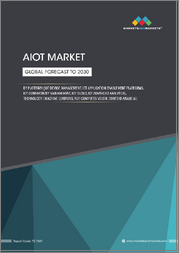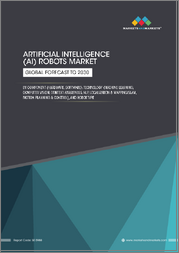
|
시장보고서
상품코드
1722602
머신러닝 칩 시장 보고서 : 기술, 칩 유형, 업계별, 지역별(2025-2033년)Machine Learning Chip Market Report by Technology (System-on-Chip, System-in-Package, Multi-chip Module, and Others), Chip Type, Industry Vertical, and Region 2025-2033 |
||||||
세계 머신러닝 칩 시장 규모는 2024년 119억 달러에 달했습니다. 향후 IMARC Group은 2033년에는 689억 달러에 달해 2025년부터 2033년까지 21.5%의 연평균 성장률(CAGR)을 기록할 것으로 예측하고 있습니다. 양자 컴퓨팅의 급속한 부상, 계산 문제를 해결하는 효율적인 시스템에 대한 수요 증가, 스마트 시티 및 스마트홈의 개발 증가 등이 시장을 이끄는 주요 요인으로 꼽힙니다.
머신러닝(ML) 칩은 딥러닝 기반 애플리케이션을 지원하도록 설계된 인공지능(AI) 기술로 구성되어 있습니다. 시스템온칩(SoC), 멀티칩 모듈, 시스템 인 패키지 등 다양한 기술이 포함되며, 하드웨어 인프라에는 컴퓨팅, 스토리지, 네트워킹이 포함됩니다. 지적 재산권 코어를 강화하고 설계 및 툴 플로우를 개선하기 위해 시스템에 설치됩니다. 비용 효율적이며, 워크플로우의 오류를 방지하고, 방대한 양의 데이터를 효율적으로 저장합니다. 고속, 고효율을 실현하고 대형 트랜지스터에 비해 에너지 소비가 적습니다. 이 외에도 성능, 전력 소비, 최적화, 분석의 향상에도 도움이 됩니다. 그 결과, ML 칩은 전 세계 자동차, 헬스케어, 소매, 미디어 및 광고, 정보기술(IT) 및 통신, 은행, 금융 서비스 및 보험(BFSI) 산업에서 널리 사용되고 있습니다.
머신러닝 칩 시장 동향:
현재 전 세계 디지털화의 진전과 IT 및 통신 산업의 확대는 시장 성장을 뒷받침하는 중요한 요인 중 하나입니다. 또한, 사이버 공격의 증가로 인해 기업들은 데이터베이스 관리 및 부정행위 탐지 시스템을 이용하고 있으며, 이는 시장 성장을 촉진하고 있습니다. 이와는 별도로 전 세계 스마트 시티 및 스마트홈의 개발로 인한 ML 칩에 대한 수요 증가는 업계 투자자들에게 유리한 성장 기회를 제공하고 있습니다. 또한, 양자 컴퓨팅의 증가는 전 세계적으로 인간의 개입과 오류를 줄이기 위해 로봇 공학에 ML 칩을 구현하는 것과 함께 시장에 긍정적인 영향을 미치고 있습니다. 이와 더불어, 수학 및 계산 문제를 해결하기 위한 효율적인 시스템에 대한 수요가 증가함에 따라 ML 칩의 채택이 증가하고 있으며, 이는 시장 전망을 밝게 하고 있습니다. 또한, 빅데이터 분석과 클라우드 컴퓨팅의 통합이 진행되어 전 세계 여러 산업에서 강화된 서비스가 제공되고 있는 것도 시장 성장에 기여하고 있습니다. 이는 실시간 소비자 행동 인사이트를 위한 ML 칩의 사용 증가와 함께 시장 성장을 촉진하고 있습니다. 또한, 게임 업계에서는 복잡한 작업을 수행하기 위해 CPU에서 GPU로 전환하는 추세가 증가하고 있으며, 이는 시장 성장을 강화하고 있습니다.
본 보고서에서 다루는 주요 질문
- 2024년 세계 머신러닝 칩 시장 규모는?
- 2025-2033년 머신러닝 칩 세계 시장 성장률 전망은?
- 머신러닝 칩 세계 시장을 이끄는 주요 요인은 무엇일까?
- COVID-19가 세계 머신러닝 칩 시장에 미치는 영향은?
- 머신러닝 칩 세계 시장에서의 기술별 분류는?
- 머신러닝 칩 세계 시장에서의 칩 유형별 분류는?
- 머신러닝 칩 세계 시장 업종별 분류는?
- 머신러닝 칩 세계 시장 주요 지역은?
- 세계 머신러닝 칩 시장의 주요 플레이어/기업은?
목차
제1장 서문
제2장 조사 범위와 조사 방법
- 조사 목적
- 이해관계자
- 데이터 소스
- 1차 정보
- 2차 정보
- 시장 추정
- 상향식 접근
- 하향식 접근
- 조사 방법
제3장 주요 요약
제4장 소개
- 개요
- 주요 업계 동향
제5장 세계의 머신러닝 칩 시장
- 시장 개요
- 시장 실적
- COVID-19의 영향
- 시장 예측
제6장 시장 내역 : 기술별
- 시스템온칩(SoC)
- 시스템 인 패키지
- 멀티칩 모듈
- 기타
제7장 시장 내역 : 칩 유형별
- 그래픽 프로세서
- ASIC
- FPGA
- CPU
- 기타
제8장 시장 내역 : 업계별
- BFSI
- IT 및 통신
- 미디어와 광고
- 소매
- 헬스케어
- 자동차
- 기타
제9장 시장 내역 : 지역별
- 북미
- 미국
- 캐나다
- 아시아태평양
- 중국
- 일본
- 인도
- 한국
- 호주
- 인도네시아
- 기타
- 유럽
- 독일
- 프랑스
- 영국
- 이탈리아
- 스페인
- 러시아
- 기타
- 라틴아메리카
- 브라질
- 멕시코
- 기타
- 중동 및 아프리카
- 시장 내역 : 국가별
제10장 SWOT 분석
- 개요
- 강점
- 약점
- 기회
- 위협
제11장 밸류체인 분석
제12장 Porter's Five Forces 분석
- 개요
- 구매자의 교섭력
- 공급 기업의 교섭력
- 경쟁 정도
- 신규 참여업체의 위협
- 대체품의 위협
제13장 가격 분석
제14장 경쟁 구도
- 시장 구조
- 주요 기업
- 주요 기업 개요
- Advanced Micro Devices Inc.
- Amazon Web Services Inc.(Amazon.com Inc.)
- Cerebras Inc.
- Google LLC
- Graphcore
- Intel Corporation
- International Business Machines Corporation
- NVIDIA Corporation
- Qualcomm Incorporated
- Samsung Electronics Co. Ltd.
- Taiwan Semiconductor Manufacturing Company Limited
The global machine learning chip market size reached USD 11.9 Billion in 2024. Looking forward, IMARC Group expects the market to reach USD 68.9 Billion by 2033, exhibiting a growth rate (CAGR) of 21.5% during 2025-2033. The rapid emergence of quantum computing, increasing demand for efficient systems to solve computational problems, and rising development of smart cities and smart homes represent some of the key factors driving the market.
Machine learning (ML) chip comprises artificial intelligence (AI) technology that that is designed to support deep learning-based applications. It involves various technologies, such as system-on-chip (SoC), multi-chip module, and system-in-package, and its hardware infrastructure includes computing, storing, and networking. It is installed in a system to enhance intellectual property cores and improve design and tool flows. It is cost-effective and assists in preventing errors in a workflow, and efficiently saves a huge amount of data. It offers high speed, increases efficiency, and consumes less energy as compared to larger transistors. Besides this, it aids in improving performance, power, optimization, and analytics. As a result, the ML chip is widely employed in the automotive, healthcare, retail, media and advertising, information technology (IT) and telecommunication, and banking, financial services, and insurance (BFSI) industries across the globe.
Machine Learning Chip Market Trends:
At present, the rising trend of digitalization and expansion of the IT and telecommunication industry around the world represent one of the key factors supporting the growth of the market. In addition, the increasing number of cyber-attacks encourages businesses to utilize database management and fraud detection systems, which is propelling the growth of the market. Apart from this, the rising demand for ML chips due to the development of smart cities and smart homes across the globe is offering lucrative growth opportunities to industry investors. Moreover, the increasing emergence of quantum computing, along with the implementation of ML chips in robotics to reduce human intervention and errors around the world, is positively influencing the market. Besides this, the growing adoption of ML chips on account of the escalating demand for efficient systems to solve mathematical and computational problems is offering a positive market outlook. Additionally, the rising integration of big data analytics and cloud computing to provide enhanced services among numerous industries across the globe is contributing to the growth of the market. This, coupled with the increasing utilization of ML chips for real-time consumer behavior insights, is impelling the growth of the market. Furthermore, the rising preference toward GPUs from CPUs to perform several complex tasks in the gaming industry is strengthening the market growth.
Key Market Segmentation:
Technology Insights:
- System-on-Chip (SoC)
- System-in-Package
- Multi-chip Module
- Others
Chip Type Insights:
- GPU
- ASIC
- FPGA
- CPU
- Others
Industry Vertical Insights:
- BFSI
- IT and Telecom
- Media and Advertising
- Retail
- Healthcare
- Automotive
- Others
Regional Insights:
- North America
- United States
- Canada
- Asia-Pacific
- China
- Japan
- India
- South Korea
- Australia
- Indonesia
- Others
- Europe
- Germany
- France
- United Kingdom
- Italy
- Spain
- Russia
- Others
- Latin America
- Brazil
- Mexico
- Others
- Middle East and Africa
- The report has also provided a comprehensive analysis of all the major regional markets, which include North America (the United States and Canada); Asia Pacific (China, Japan, India, South Korea, Australia, Indonesia, and others); Europe (Germany, France, the United Kingdom, Italy, Spain, Russia, and others); Latin America (Brazil, Mexico, and others); and the Middle East and Africa. According to the report, North America (the United States and Canada) was the largest market for machine learning chip. Some of the factors driving the North America machine learning chip market included the growing concern about security of critical infrastructure, increasing demand for quantum computing, rising utilization in the IT industry, etc.
Competitive Landscape:
- The report has also provided a comprehensive analysis of the competitive landscape in the global machine learning chip market. Competitive analysis such as market structure, market share by key players, player positioning, top winning strategies, competitive dashboard, and company evaluation quadrant has been covered in the report. Also, detailed profiles of all major companies have been provided. Some of the companies covered include Advanced Micro Devices Inc., Amazon Web Services Inc. (Amazon.com Inc.), Cerebras Inc., Google LLC, Graphcore, Intel Corporation, International Business Machines Corporation, NVIDIA Corporation, Qualcomm Incorporated, Samsung Electronics Co. Ltd., Taiwan Semiconductor Manufacturing Company Limited., etc. Kindly note that this only represents a partial list of companies, and the complete list has been provided in the report.
Key Questions Answered in This Report
- 1.What was the size of the global machine learning chip market in 2024?
- 2.What is the expected growth rate of the global machine learning chip market during 2025-2033?
- 3.What are the key factors driving the global machine learning chip market?
- 4.What has been the impact of COVID-19 on the global machine learning chip market?
- 5.What is the breakup of the global machine learning chip market based on the technology?
- 6.What is the breakup of the global machine learning chip market based on the chip type?
- 7.What is the breakup of the global machine learning chip market based on the industry vertical?
- 8.What are the key regions in the global machine learning chip market?
- 9.Who are the key players/companies in the global machine learning chip market?
Table of Contents
1 Preface
2 Scope and Methodology
- 2.1 Objectives of the Study
- 2.2 Stakeholders
- 2.3 Data Sources
- 2.3.1 Primary Sources
- 2.3.2 Secondary Sources
- 2.4 Market Estimation
- 2.4.1 Bottom-Up Approach
- 2.4.2 Top-Down Approach
- 2.5 Forecasting Methodology
3 Executive Summary
4 Introduction
- 4.1 Overview
- 4.2 Key Industry Trends
5 Global Machine Learning Chip Market
- 5.1 Market Overview
- 5.2 Market Performance
- 5.3 Impact of COVID-19
- 5.4 Market Forecast
6 Market Breakup by Technology
- 6.1 System-on-Chip (SoC)
- 6.1.1 Market Trends
- 6.1.2 Market Forecast
- 6.2 System-in-Package
- 6.2.1 Market Trends
- 6.2.2 Market Forecast
- 6.3 Multi-chip Module
- 6.3.1 Market Trends
- 6.3.2 Market Forecast
- 6.4 Others
- 6.4.1 Market Trends
- 6.4.2 Market Forecast
7 Market Breakup by Chip Type
- 7.1 GPU
- 7.1.1 Market Trends
- 7.1.2 Market Forecast
- 7.2 ASIC
- 7.2.1 Market Trends
- 7.2.2 Market Forecast
- 7.3 FPGA
- 7.3.1 Market Trends
- 7.3.2 Market Forecast
- 7.4 CPU
- 7.4.1 Market Trends
- 7.4.2 Market Forecast
- 7.5 Others
- 7.5.1 Market Trends
- 7.5.2 Market Forecast
8 Market Breakup by Industry Vertical
- 8.1 BFSI
- 8.1.1 Market Trends
- 8.1.2 Market Forecast
- 8.2 IT and Telecom
- 8.2.1 Market Trends
- 8.2.2 Market Forecast
- 8.3 Media and Advertising
- 8.3.1 Market Trends
- 8.3.2 Market Forecast
- 8.4 Retail
- 8.4.1 Market Trends
- 8.4.2 Market Forecast
- 8.5 Healthcare
- 8.5.1 Market Trends
- 8.5.2 Market Forecast
- 8.6 Automotive
- 8.6.1 Market Trends
- 8.6.2 Market Forecast
- 8.7 Others
- 8.7.1 Market Trends
- 8.7.2 Market Forecast
9 Market Breakup by Region
- 9.1 North America
- 9.1.1 United States
- 9.1.1.1 Market Trends
- 9.1.1.2 Market Forecast
- 9.1.2 Canada
- 9.1.2.1 Market Trends
- 9.1.2.2 Market Forecast
- 9.1.1 United States
- 9.2 Asia-Pacific
- 9.2.1 China
- 9.2.1.1 Market Trends
- 9.2.1.2 Market Forecast
- 9.2.2 Japan
- 9.2.2.1 Market Trends
- 9.2.2.2 Market Forecast
- 9.2.3 India
- 9.2.3.1 Market Trends
- 9.2.3.2 Market Forecast
- 9.2.4 South Korea
- 9.2.4.1 Market Trends
- 9.2.4.2 Market Forecast
- 9.2.5 Australia
- 9.2.5.1 Market Trends
- 9.2.5.2 Market Forecast
- 9.2.6 Indonesia
- 9.2.6.1 Market Trends
- 9.2.6.2 Market Forecast
- 9.2.7 Others
- 9.2.7.1 Market Trends
- 9.2.7.2 Market Forecast
- 9.2.1 China
- 9.3 Europe
- 9.3.1 Germany
- 9.3.1.1 Market Trends
- 9.3.1.2 Market Forecast
- 9.3.2 France
- 9.3.2.1 Market Trends
- 9.3.2.2 Market Forecast
- 9.3.3 United Kingdom
- 9.3.3.1 Market Trends
- 9.3.3.2 Market Forecast
- 9.3.4 Italy
- 9.3.4.1 Market Trends
- 9.3.4.2 Market Forecast
- 9.3.5 Spain
- 9.3.5.1 Market Trends
- 9.3.5.2 Market Forecast
- 9.3.6 Russia
- 9.3.6.1 Market Trends
- 9.3.6.2 Market Forecast
- 9.3.7 Others
- 9.3.7.1 Market Trends
- 9.3.7.2 Market Forecast
- 9.3.1 Germany
- 9.4 Latin America
- 9.4.1 Brazil
- 9.4.1.1 Market Trends
- 9.4.1.2 Market Forecast
- 9.4.2 Mexico
- 9.4.2.1 Market Trends
- 9.4.2.2 Market Forecast
- 9.4.3 Others
- 9.4.3.1 Market Trends
- 9.4.3.2 Market Forecast
- 9.4.1 Brazil
- 9.5 Middle East and Africa
- 9.5.1 Market Trends
- 9.5.2 Market Breakup by Country
- 9.5.3 Market Forecast
10 SWOT Analysis
- 10.1 Overview
- 10.2 Strengths
- 10.3 Weaknesses
- 10.4 Opportunities
- 10.5 Threats
11 Value Chain Analysis
12 Porters Five Forces Analysis
- 12.1 Overview
- 12.2 Bargaining Power of Buyers
- 12.3 Bargaining Power of Suppliers
- 12.4 Degree of Competition
- 12.5 Threat of New Entrants
- 12.6 Threat of Substitutes
13 Price Analysis
14 Competitive Landscape
- 14.1 Market Structure
- 14.2 Key Players
- 14.3 Profiles of Key Players
- 14.3.1 Advanced Micro Devices Inc.
- 14.3.1.1 Company Overview
- 14.3.1.2 Product Portfolio
- 14.3.2 Amazon Web Services Inc. (Amazon.com Inc.)
- 14.3.2.1 Company Overview
- 14.3.2.2 Product Portfolio
- 14.3.2.3 SWOT Analysis
- 14.3.3 Cerebras Inc.
- 14.3.3.1 Company Overview
- 14.3.3.2 Product Portfolio
- 14.3.4 Google LLC
- 14.3.4.1 Company Overview
- 14.3.4.2 Product Portfolio
- 14.3.4.3 SWOT Analysis
- 14.3.5 Graphcore
- 14.3.5.1 Company Overview
- 14.3.5.2 Product Portfolio
- 14.3.6 Intel Corporation
- 14.3.6.1 Company Overview
- 14.3.6.2 Product Portfolio
- 14.3.7 International Business Machines Corporation
- 14.3.7.1 Company Overview
- 14.3.7.2 Product Portfolio
- 14.3.8 NVIDIA Corporation
- 14.3.8.1 Company Overview
- 14.3.8.2 Product Portfolio
- 14.3.9 Qualcomm Incorporated
- 14.3.9.1 Company Overview
- 14.3.9.2 Product Portfolio
- 14.3.10 Samsung Electronics Co. Ltd.
- 14.3.10.1 Company Overview
- 14.3.10.2 Product Portfolio
- 14.3.11 Taiwan Semiconductor Manufacturing Company Limited
- 14.3.11.1 Company Overview
- 14.3.11.2 Product Portfolio
- 14.3.1 Advanced Micro Devices Inc.



















